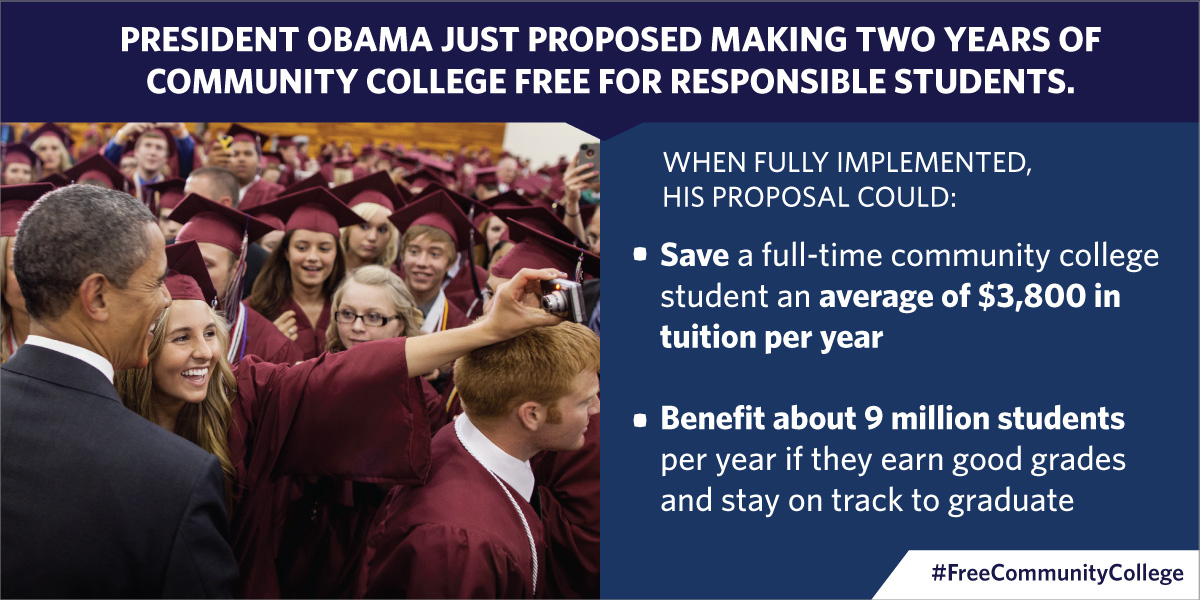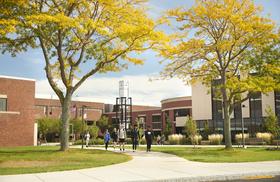So you want to go to college but can’t afford it. Perhaps you don’t want to take out loans that will take decades to pay off. Or maybe you don’t think you’d get many (or any) scholarships or grants because your grades are good enough but not that great or because you make just enough money not to be considered in great financial need.
If the President has his way, none of this will matter.
In January, in his State of the Union Address, President Obama outlined a $60 billion plan to make community college free for everyone. While ‘everyone’ doesn’t actually mean everyone, the plan would still open many doors for students who may not otherwise be able to attend college.
What are the Criteria?
The criteria for a tuition-free community college under the Obama plan are straightforward. Students must maintain a 2.5 GPA, which leads to a smattering of Bs and Cs – grades that most students quickly achieve. Attendance must be at least half-time, which is typically considered to be six or more credit hours each semester. That’s just two classes per semester, which is easily achievable by most students, even those who work or have other obligations outside of school. In short, students who put in the effort would get a free education.
There is, however, a third criterion. To limit the program's long-term costs, the plan would be made available only to students whose family’s Adjusted Gross Income (AGI) is under $200,000 per year. While this news would not impact poor, low-income, and lower-middle-class students, those students from middle and upper-middle-class families would not be able to take advantage of the program. Although it might be assumed that this income cap would impact many community college students, it would not. A mere 2.7 percent of dependent community college students come from a family with an annual income greater than $200,000, meaning most of today’s students would qualify for the program, at least from an income perspective.
Would It Work?

Although a nationwide program to make community college free has never been undertaken, several states have made such a move. In Tennessee, a whopping 90 percent of high school seniors are enrolling in college as part of that state’s free college plan, called Tennessee Promise. Tennessee Promise offers eligible students two years of tuition-free education at their chosen community college or technical school.
Efforts in other states to make community college more affordable are on the table. In Oregon, state lawmakers are pushing for a plan similar to Tennessee’s, which might encourage the estimated 70,000 idle youth in Oregon – young people between the ages of 16 and 24 who have no job and are not attending school – to head to college. In California, students have gotten a community college education for free for decades. Nearly two-thirds of that state’s 17- to 19-year-olds receive a full tuition waiver because they meet low-income restrictions. Furthermore, students who receive a Pell Grant also receive a tuition waiver, meaning they have additional money for expenses such as room and board.
Other efforts to reduce college expenses have had varying levels of success. In New York City, roughly half of the City University of New York system students pay no tuition due to federal and state tuition assistance programs. Lawmakers in Mississippi and Massachusetts have proposed tuition-free plans in the past, only to see their proposals die on the table.
The Obama plan would mimic these existing and proposed state plans but on a much larger scale. The success of the Tennessee Promise plan (upon which Obama’s plan is based), in particular, indicates that a nationwide tuition-free plan for community college would be feasible and offer a substantial measure of success for community college students.
Why Now?

Indeed, the rising cost of college is a central reason President Obama has chosen to tackle this issue now. However, other reasons highlight the need for such a program.
In his speech, President Obama compared community college today to high school one hundred years ago. Back then, business and industry needed workers with basic skills, thus universal K-12 education took root. However, today’s in-demand jobs require far more than basic skills students acquire in high school. While plenty of jobs are out there for high school graduates, good jobs (with good incomes) require at least a two-year degree or certificate.
As the economy has shifted to more vocationally based occupations in recent years, community colleges have borne most of the burden of training workers for these highly technological positions. With many of these jobs, such as those in the healthcare industry, in dire need of workers, making tuition free would bring more students into the educational fold while preparing more workers for the continued demand for services.
Another reason why the President’s plan is being mentioned now is because the economy is finally recovering from the Great Recession. With more money in the coffers, the government’s ability to foot the bill for a 10-year, $60 billion program is more significant than in years. However, just because the money is there does not mean the program is a surefire bet to come to fruition.
What Students Need To Know
There are, of course, several things potential benefactors of this program must bear in mind. First and foremost, if you are a current or soon-to-be college student, know that even if this proposal becomes a reality, it will be years before it is implemented. If you’re looking for immediate relief from the high expenses of college, you will have to wait. The current mood in Washington, D.C., is not one of excellent cooperation and progress, and a plan with a $60 billion price tag is likely to draw criticism and opposition from conservatives who oppose additional expenditures, even though $60 billion is a chump change in light of the federal government’s massive overall budget.
Second, while Obama’s plan, America’s College Promise, is largely based on the Tennessee Promise plan, there is one significant difference. Whereas the Tennessee plan is open only to recent high school graduates, America’s College Promise would also make free tuition available to non-traditional students. Since the average age of a community college student is 28, this is good news.
Third, America’s College Promise would cover tuition for associate’s degrees and courses that can be transferred to a bachelor’s degree program. Additionally, certificate programs would qualify for free tuition, giving students several options when deciding how best to pursue their education.
Lastly, in its current form, America's College Promise would require individual states to pay for approximately 25 percent of the bill. While some states are open to the idea and have funding sources available, others have either been unwilling to consider such programs, don’t have the money to pay for such programs, or both.
Conclusion
Regardless of the somewhat likely scenario that America’s College Promise doesn’t ever come to fruition, it poses a glimmer of hope that lawmakers are at least thinking about how expensive college has become and are thinking of ways to improve access to higher education, particularly for poor students. Perhaps if a nationwide program for tuition-free community college isn’t viable, the discussion that has resulted from such a proposal may induce states to tackle the issue themselves. As millions of college students look on, there is at least some hope that a more affordable college education is on the horizon.
Questions? Contact us on Facebook. @communitycollegereview















